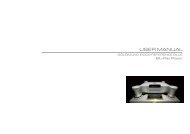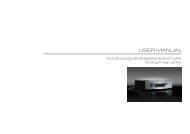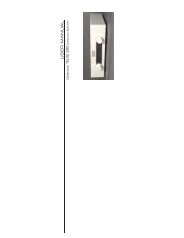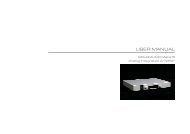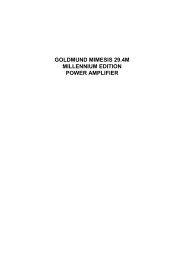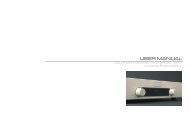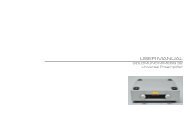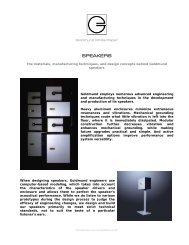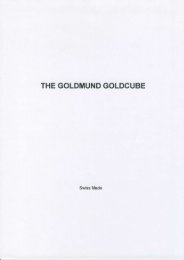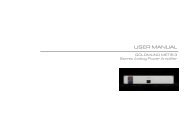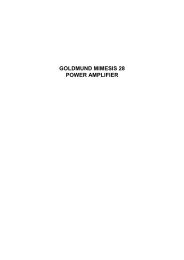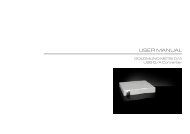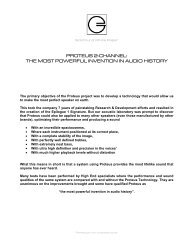THE GOLDMUND EPILOGUE 3/4 SUB-BASS SPEAKER SYSTEM
THE GOLDMUND EPILOGUE 3/4 SUB-BASS SPEAKER SYSTEM
THE GOLDMUND EPILOGUE 3/4 SUB-BASS SPEAKER SYSTEM
Create successful ePaper yourself
Turn your PDF publications into a flip-book with our unique Google optimized e-Paper software.
<strong>THE</strong> <strong>GOLDMUND</strong> <strong>EPILOGUE</strong> 3/4<br />
<strong>SUB</strong>-<strong>BASS</strong> <strong>SPEAKER</strong> <strong>SYSTEM</strong><br />
USER MANUAL
<strong>THE</strong> <strong>GOLDMUND</strong> <strong>EPILOGUE</strong> 3/4<br />
<strong>SUB</strong>-<strong>BASS</strong> <strong>SPEAKER</strong> <strong>SYSTEM</strong><br />
USER MANUAL
CONGRATULATIONS<br />
Thank you for purchasing the Goldmund Epilogue Speaker.<br />
You have acquired the best Speaker ever made for professional and domestic uses.<br />
Please take some time to read this manual. It may provide you with useful<br />
information to make your pleasure of listening to the Epilogue even higher.<br />
WARNING !<br />
This extremely high quality speaker possess new technical features which are a<br />
necessity for an accurate sound reproduction in the best audio systems.<br />
Only careful installation and use can provide the satisfaction you are expecting.<br />
The installation instructions must be scrupulously carried out and the mentioned<br />
precautions taken to get the expected result and to avoid to deteriorate the speaker.<br />
If the unused input is not short-circuited properly as<br />
indicated below, warranty does not apply.<br />
Nevertheless, if the instructions are perfectly carried out, you will notice that the<br />
sound quality of your Goldmund Epilogue system is incredibly dynamic, precise and<br />
sweet.<br />
NOTE : The speaker has been assembled for a full testing at the factory with the<br />
associated other speakers. It is perfectly normal that some metallic parts show some<br />
slight marking from this preliminary assembly process.<br />
3
1. PRELIMINARIES<br />
The Goldmund Epilogue 3/4 uses the same very innovative technology than the<br />
Epilogue 2 to achieve a level of definition and neutrality never found before in a subbass<br />
speaker system.<br />
Please read very carefully the following instructions. This high-precision speaker is<br />
extremely revealing and can provide the best sound only if it is used properly.<br />
The Epilogue 3/4 is never used as a stand-alone speaker. Its most usual<br />
configuration is associated to a pair of Epilogue 1 Satellite Speakers or by 2 units<br />
included in a pair of Full Epilogue Speaker. See below the assembly instructions for<br />
the Full Epilogue Speaker System.<br />
2. UNPACKING <strong>THE</strong> <strong>EPILOGUE</strong> 3/4<br />
ATTENTION : Do not unpack the Epiframe cartons yet. The parts are much easier<br />
to recognize by the indication we provide in the following instructions giving their<br />
provenance from the Epiframe 1 or Epiframe 2 assemblies.<br />
ATTENTION : If you need to return the speaker to the factory or to your local<br />
representative for a warranty repair, please note that it must be repacked in the<br />
original packing. Otherwise new packing will be charged as well as the repair of<br />
damages occurred due to poor packing conditions.<br />
SPECIAL NOTICE : The dealer who sold you the Epilogue also received a very<br />
practical tool to install the Epilogue 3. Called the Epilogue "Helm", this rolling device<br />
allows the Epilogue 3 to be rolled by a single person with perfect safety. The<br />
Epilogue "Helm" may also be used for small moves when the full Epilogue has been<br />
assembled if enough care is taken about vertical stability.<br />
If you want to keep this accessory for yourself, it can also be purchased separately.<br />
It is necessary to be four people to install the <strong>EPILOGUE</strong> 3/4, because the speaker<br />
is extremely heavy and some handling steps necessitate a lot of care. Do not try to<br />
do any assembly without the necessary help.<br />
Cut the Epilogue 3/4 box attachments and remove the cover of the box.<br />
Do not move the speaker now.<br />
4
To manipulate safely the Epilogue 3/4, you need to use accessories located in the<br />
separate accessory box that your dealer has received, called the "Helm" box.<br />
Open the "Helm" box. Locate the front panel attachment block (the heavy steel block)<br />
and plug it on the two steel bars protruding from the lower part of the speaker front<br />
panel (the large circular hole must be directed toward the floor).<br />
Secure the block by the left and right screws.<br />
Take from the same "Helm" box the 4 handling steel bars. The two threaded bars<br />
must be locked tightly inside the front steel block (one on each side).<br />
Insert the two other bars in the lodging under the speaker (on the rollers supports).<br />
The bar must be inserted fully inside the three aligned holes on each side. Tighten<br />
the back screw to avoid the bar to move when the speaker will be carried.<br />
You have now 4 handles to lift and move the speaker safely. After the Epilogue 3/4 is<br />
on the floor at the selected position you will remove these handles and the front steel<br />
block and return it to your dealer.<br />
After unpacking, and despite its extreme weight, the Epilogue 3/4 may still be moved<br />
easily with the provided rolling accessory, the "Helm" roller. However, when fully<br />
assembled, especially in the Full Epilogue configuration, the weight makes the<br />
movement quite delicate, especially on thick carpeted floors.<br />
For these reasons, it is best to locate the Epilogue 3/4 in its final position before<br />
starting assembling the full system.<br />
3. SELECTING <strong>THE</strong> <strong>EPILOGUE</strong> 3/4 LOCATION<br />
A very rigid floor is very important for the optimal sonic result of your Epilogue<br />
speakers. Select a position of the speaker to have the most rigid possible coupling<br />
with the floor. Solid coupling is essential, and if your support is standing on a<br />
suspended floor, optimal result requires that you arrange the support to have at least<br />
the pointed foot above a supporting beam or close enough from a supporting wall.<br />
ATTENTION : The pointed foot supporting the front of the Epilogue 3/4 is very hard.<br />
It is designed to go through a carpeted floor. If your floor is made of wood or tile, be<br />
careful not to scratch it by moving a speaker without lifting the point.<br />
If you have a thick carpet, the pointed bar may go too deep inside the carpeting and<br />
the speaker will not raise high enough for the proper adjustment of its feet. You can<br />
make the pointed bar longer by inserting a provided steel washer between the bar<br />
and the enclosure.<br />
5
4. ADJUSTING <strong>THE</strong> <strong>EPILOGUE</strong> 3/4 FEET<br />
When the Epilogue 3/4 is set in position, the 4 adjustable corner feet must be<br />
adjusted as follow.<br />
The two front feet are only set to avoid the speaker to balance if it moved. They must<br />
go down to the floor without pressure. The weight of the front part of the Epilogue 3/4<br />
is and must be on the pointed central foot.<br />
The back feet, on the contrary must be use to raise the back of the speaker to make<br />
the front to back horizontal. Use a bubble level to adjust that level.<br />
In addition, separate adjustment of the right and left back feet provide a left/right<br />
horizontal adjustment.<br />
If the speaker has to be moved later, the two back feet will have to be recessed until<br />
the speaker can be rolled on its back rollers.<br />
5. ASSEMBLY OF <strong>THE</strong> FULL <strong>EPILOGUE</strong> (only for Full Epilogue Setup)<br />
The Full Epilogue System is made of, for each channel :<br />
• One Epilogue 3 or Epilogue 4 Sub-Bass.<br />
• One Epilogue 1 lower Satellite mounted vertically on top of the Epilogue 3/4.<br />
• One Epilogue 2 mounted on its side (the larger sides being horizontal).<br />
• One Epilogue 1 upper Satellite mounted vertically in inverted position (upside<br />
down, the tweeter becoming the lower driver).<br />
You must prepare each of these speakers and the parts of the Epiframe 1 before<br />
starting the final assembly. Please carefully execute the following steps :<br />
A. Lower Epilogue 1 preparation<br />
• Dismount the gold plated top plate from the Epilogue 1 that will be assembled in<br />
the lower position.<br />
• Mount where the golden plate was the silver steel plate provided with the<br />
Epiframe 2. Attach it with the provided silver screws.<br />
• Mount into the bottom threaded hole one of the black pointed steel bars provided<br />
with the Epiframe 2. Tighten it using a strong screwdriver inserted in its lateral<br />
hole.<br />
6
B. Epilogue 2 preparation<br />
• Dismount the top silver steel plate.<br />
• Dismount the two gold plated side identification plates.<br />
• Reassemble the silver steel plate in one of the lateral sides (one of the larger<br />
sides). Use the side which is the closest to the coaxial connector located on the<br />
back panel and noted Epilogue 1.<br />
• Reassemble the two gold plated identification plates to the two smaller sides.<br />
• Mount on the bottom threaded hole of the remaining larger side one of the black<br />
pointed steel bars provided in the Epiframe 2. Tighten it using a strong<br />
screwdriver inserted in its lateral hole.<br />
C. Upper Epilogue 1 Satellite preparation<br />
• Dismount the gold plated top plate.<br />
• Mount on the threaded hole that was hidden by the gold plate one of the black<br />
pointed steel bars provided with the Epiframe 1 (similar to those found earlier in<br />
the package of the Epiframe 2). Tighten it using a strong screwdriver inserted in<br />
its lateral hole. Fill the small holes around with no-head plastic screws provided.<br />
The speakers are now ready to be assembled.<br />
However, the Epiframe assembly needs also to be prepared before.<br />
The Epilogue Epiframe is designed to provide stability of the full Epilogue assembly.<br />
Prepare the following elements before assembling the speakers.<br />
If you upgrade from an Epiframe 1 to the full system, dismount first the Epiframe 1<br />
from any speakers attachment and follow the process described below :<br />
D. Epiframe 1 preparation<br />
• From the Epiframe 1 you must first disassemble the bottom rectangular assembly.<br />
See Schematics #1<br />
• Attach the two vertical bars found in the Epiframe 1 carton with the bottom feet<br />
taken from the above disassembly (part A). The bottom feet part is assembled on<br />
the longest length without screws.<br />
• Insert two 80mm long tubes on the available tube holders. Use rounded head<br />
screws provided to attach each.<br />
See Schematics #2<br />
• Assemble the two vertical bars on the back of the Epilogue 3/4 speaker.<br />
• Remove the golden plates from the front bar disassembled previously (part C).<br />
• Assemble one tube holder on top of a Teflon isolator on the corner side from<br />
where the golden plate was removed. Use 2 M5x30 screws. And do the same<br />
under. See Schematics #3<br />
• Insert the two midsize tubes found in the Epiframe 2 cartons with satellite<br />
attachment and use two rounded head screws to tighten each of them.<br />
• Assemble this built U shaped frame part on top of the two vertical bars mounted<br />
on the back of the Epilogue 3.<br />
7
• Keep the U shaped part found in the Epiframe 1 carton for the upper satellite<br />
frame assembly.<br />
E. Installation of the lower satellite<br />
• Take two short transparent plexiglas feet found in the Epiframe cartons (they are<br />
all identical). Put them standing on top of the Epilogue 3. Their height is 5cm.<br />
• Carefully approach the lower Epilogue 1 Satellite to be put on top of the Epilogue<br />
3. The Satellite will have its bottom pointed bar inserted in the silver steel plate<br />
glide and will be put on the 2 transparent feet on the back.<br />
• Have one person guide the pointed bar to its lodging without scratching the<br />
Epilogue 3 speaker surface.<br />
• Arrange the two transparent feet to be aligned with the back corners of the<br />
speaker.<br />
• When the Epilogue 1 is in position, attach the two lateral arms of the frame to its<br />
sides using the long Steel screws, the golden nuts, 2 teflon ring and the cylindrical<br />
"molette". Please check the following schematics.<br />
See Schematics #4<br />
F. Installation of the Epilogue 2<br />
• This is one of the most critical steps of the whole assembly. The Epilogue 2 is<br />
very heavy and should be lifted on top of the Epilogue 1 lower satellite where it<br />
will sit on its steel pointed bar and 2 transparent plexiglas feet. The position will<br />
remain<br />
G. Installation of the Epiframe 2<br />
• Insert the two vertical long bars of the Epiframe 2 on top of the lower frame<br />
assembly.<br />
• Attach the 4 blocks of the Epiframe 2 to the back panel of the Epilogue 2 using<br />
long M5 screws.<br />
• Insert the U shaped top assembly of the frame. Secure with the rounded head<br />
screws.<br />
H. Installation of the Upper Epilogue 1 Satellite<br />
• Take two short transparent plexiglas feet found in the Epiframe cartons (they are<br />
all identical). Put them standing on top of the Epilogue 2. Their height is 5cm.<br />
• Carefully approach the upper Epilogue 1 Satellite to be put on top of the Epilogue<br />
2. The Satellite will have its pointed bar inserted in the silver steel plate glide and<br />
will be put on the 2 transparent feet on the back.<br />
• Have one person guide the pointed bar to its lodging without scratching the<br />
Epilogue 2 speaker surface.<br />
8
• Arrange the two transparent feet to be aligned with the back corners of the<br />
speaker.<br />
• When the Epilogue 1 is in position, attach the two lateral arms of the frame to its<br />
sides using the long Steel screws, the golden nuts, 2 teflon ring and the cylindrical<br />
"molette". Please check the above schematics.<br />
6. <strong>SPEAKER</strong>S PHYSICAL ALIGNMENT<br />
To arrive to the listener simultaneously, the waves front created by each speaker<br />
section have to be aligned to be at an equal distance from the listener position. This<br />
is more critical in Stereo use than in multi-channel where the levels and delay of each<br />
speaker are adjusted separately.<br />
The departure position is when the rear part of each speaker's grill is vertically<br />
aligned.<br />
The Epilogue frame has been designed to allow the displacement of each speaker<br />
section separately. The exact alignment may be obtained by measurements<br />
However, a simple rule shows that for a listener seating at 3m5 (12') from the<br />
speakers and with the hear level at the lower Epilogue 1 level, the displacement<br />
needed are as follows, the Epilogue 3/4 being used as a reference :<br />
• The lower satellite must be pushed back by 25mm (1").<br />
• The Epilogue is aligned with Epilogue 3/4<br />
• The upper satellite must be advanced by 50mm from the Epilogue 2.<br />
For a seating position at 6m (20'), the displacements would be :<br />
• The lower satellite must be pushed back by 12mm (1/2").<br />
• The Epilogue is aligned with Epilogue 3/4.<br />
• The upper satellite must be advanced by 28mm (1¼") from the Epilogue 2.<br />
7. <strong>SPEAKER</strong> CONNECTIONS<br />
Used in any type of configuration, the Epilogue 3/4 has a built-in amplifier and a builtin<br />
input crossover.<br />
The Epilogue 4 allows the input signal to be digital and provides two additional<br />
switches to select the analogue or digital inputs and which channel of the SPDIF<br />
signal is used.<br />
9
The only connections needed are the Power cord and the interconnect linking the<br />
Epilogue 3 to the output of the preamplifier, or if you use the Epilogue 4 in digital, use<br />
a digital link cable for input.<br />
The Epilogue 3/4 may receive two analogue cables if one only one Epilogue 3/4 is<br />
used so the right and left channels may be mixed automatically inside the crossover.<br />
ATTENTION : If you use 2 x Epilogue ¾ in analogue, you have only one cable<br />
that can be connected to any of the two available RCA inputs. In such a case,<br />
always leave the unused input on each Epilogue 3/4 with a short-circuiting plug<br />
mounted.<br />
ATTENTION : In most configurations, the ground wire from AC plug must<br />
absolutely be lifted on all amplifiers and on the Epilogue 3/4 connection to the<br />
AC line. Otherwise a bad ground loop may make amplifiers oscillate and be<br />
destroyed.<br />
The Epilogue 3/4 is automatically powered ON when it receives modulation.<br />
For the Epilogue Full System connection, several possibilities are accessible.<br />
The connection is different if the speakers are used in a multi-channel system or in a<br />
2 channels system :<br />
A. Connection in a Multi-Channel system :<br />
If used in a multi-channel system :<br />
• The 2 x Epilogue 3/4 are connected in parallel to the sub-woofer channel.<br />
• The lower Epilogue 1 Satellites are connected in mono (parallel) to the center<br />
channel.<br />
• The Epilogue 2 and upper Epilogue 1 satellite are the main right and left<br />
channels. These two speakers may be connected to their respective or common<br />
amplifier in three different ways as described below :<br />
10
A1. One single Amplifiers with one set of Speaker cables :<br />
NOTE : When using non-Goldmund speaker cable, the 5-way binding posts may be<br />
used for the amplifiers connection instead of the coaxial input.<br />
Try using highest quality banana plugs which can be tighten in position.<br />
However, it is far better to use the Goldmund Speaker Cable to allow the speed of<br />
the amplifier to properly control the drivers. Any speaker cable of lower quality or<br />
speed can ruin the sonic capabilities of the Epilogue System.<br />
When using the Goldmund Speaker Cable, the Speaker Adapter can be avoided and<br />
the coaxial cable directly connected to the large coaxial connectors provided on the<br />
speaker back panel.<br />
The sonic improvement which can be achieved in the best systems is quite dramatic.<br />
11
A2. One single Amplifier with two set of Speaker cables (bi-wiring) :<br />
NOTE : When using non-Goldmund speaker cable, the 5-way binding posts may be<br />
used for the amplifiers connection instead of the coaxial input.<br />
Try using highest quality banana plugs which can be tighten in position.<br />
However, it is far better to use the Goldmund Speaker Cable to allow the speed of<br />
the amplifier to properly control the drivers. Any speaker cable of lower quality or<br />
speed can ruin the sonic capabilities of the Epilogue System.<br />
12
When using the Goldmund Speaker Cable, the Speaker Adapter can be avoided and<br />
the coaxial cable directly connected to the large coaxial connectors provided on the<br />
speaker back panel.<br />
The sonic improvement which can be achieved in the best systems is quite dramatic.<br />
A3. Two Amplifiers and two set of Speaker cables :<br />
NOTE : When using non-Goldmund speaker cable, the 5-way binding posts may be<br />
used for the amplifiers connection instead of the coaxial input.<br />
Try using highest quality banana plugs which can be tighten in position.<br />
However, it is far better to use the Goldmund Speaker Cable to allow the speed of<br />
the amplifier to properly control the drivers. Any speaker cable of lower quality or<br />
speed can ruin the sonic capabilities of the Epilogue System.<br />
13
When using the Goldmund Speaker Cable, the Speaker Adapter can be avoided and<br />
the coaxial cable directly connected to the large coaxial connectors provided on the<br />
speaker back panel.<br />
The sonic improvement which can be achieved in the best systems is quite dramatic.<br />
B. Connection in a 2 channel Stereo system :<br />
The Upper Epilogue 1 satellite and Epilogue 2 Bass enclosure may be connected as<br />
above and the same 3 possibilities exist, here too.<br />
However, the importance of level matching in the Full Epilogue System used in<br />
Stereo is extremely critical, and amplifiers with input level adjustment are a practical<br />
necessity.<br />
More, using two separate amplifiers for Epilogue 2 and the upper Epilogue 1 Satellite<br />
is allowing a separate adjustment of the Epilogue 2 and Upper Epilogue 1 which is<br />
very helpful in the system final tonal balance.<br />
The lower Epilogue 1 Satellite amplifier is connected to the same preamplifier output.<br />
However, if the system has to be used at high levels, a protection circuit has to be<br />
inserted in the amplifier input circuit, in order to limit its bandwidth.<br />
The ultimate solution is an additional passive crossover made by Goldmund which is<br />
exactly adapting the level, frequency response and Group Delay of the second<br />
satellite to mirror the upper satellite. See your dealer for availability.<br />
For a perfect tonal balance, it is recommended to adjust the level of the amplifiers<br />
connected to the Epilogue 2 individually. A power amplifier with built-in level<br />
adjustment like the Mimesis 29.4 may be helpful.<br />
When each separate speaker is individually powered by a Mimesis 29.4 and the<br />
lower Epilogue 1 special crossover is used for the lower Epilogue 1 speaker, the<br />
theoretical adjustments are as follow :<br />
• Upper Epilogue 1 : -6dB<br />
• Epilogue 2 : -3dB<br />
• Lower Epilogue 1 : -6dB<br />
• Epilogue 3/4 : Crossover in position 1 or 2. Volume ¾ to full.<br />
The Epilogue ¾ analogue input interconnect has to be connected in parallel form the<br />
output of the preamplifier with the other amplifiers.<br />
14
You may finally have 4 interconnects connected to the same preamp output. To<br />
avoid the detrimental effect of bad Y connectors, it may be necessary to have a<br />
separation box built especially for this atypical application. Please consult your<br />
Goldmund dealer for advice.<br />
For best performance, use a preamplifier with very low output impedance so several<br />
amplifiers may be used without signal loss. The Mimesis 22 is especially adapted. Its<br />
two separate inputs may be used to feed each 2 amplifiers.<br />
For the best performance, use one output for Epilogue 2 and top Satellite, and one<br />
output for lower Satellite and Epilogue 3/4.<br />
7. RUNNING-IN FOR <strong>THE</strong> <strong>EPILOGUE</strong> 3/4<br />
The Epilogue 3/4, like the Epilogue 2 and the Epilogue 1 needs several days playing<br />
music before providing the top sonic quality it is built to provide.<br />
The few first hours can be very frustrating for a demanding listener.<br />
Do not hesitate to let it play quite loud some time before attempting any real system<br />
tuning or position adjustment.<br />
8. CLEANING <strong>THE</strong> <strong>EPILOGUE</strong> 3<br />
To clean the metal case of the speaker, you can use a wet cloth. Always use a very<br />
soft cloth to avoid scratching the surface.<br />
The identification plates are gold plated. Simply clean them with a soft cloth, without<br />
any chemical solution.<br />
15
SPECIFICATIONS<br />
Epilogue 3/4<br />
Amplifier Analogue Input Impedance : > 100 kOhms.<br />
Amplifier maximum power : 500 W Rms.<br />
Bandwidth :<br />
• Low Frequency Cutoff : < 22 Hz -3dB.<br />
Drivers : 8 x 21 cm Velvet Kevlar proprietary drivers mounted 4x2 in inverted push-pull with<br />
front speaker mounted backwards.<br />
Electronic Crossover : 3 separate frequencies (5 in Epilogue 4). Master level control.<br />
Bass Load : vent loading. 4 separately tuned flexible vents.<br />
Size and Weight :<br />
• Weight of one Epilogue 3/4 sub-woofer : 140 kg.<br />
• Size of an Epilogue 3/4 sub-woofer : 78 cm (H) x 52 cm (W) x 72 cm (D).<br />
Full System<br />
Size and Weight of the Full system :<br />
• Total Height of the full speaker : 2 meters.<br />
• Total Width of the full speaker : 52 cm.<br />
• Total Depth of the full speaker : 80 cm.<br />
• Total Weight of one full speaker : > 320 kg.<br />
16




